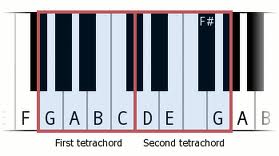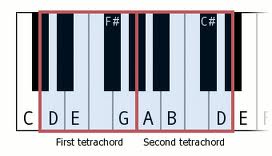If you already know some things about tetrachords and major scales, then learning how to build the sharp scales will be a breeze.
First, let’s review what a tetrachord is…
Tetrachords
1) A tetrachord is a mini-scale containing 4 notes with a specific pattern of whole steps and half steps.
2) The pattern of a tetrachord used to create a major scale looks like this: Whole Step – Whole Step – Half Step.
3) The 4 notes of a tetrachord must be in alphabetical order following the musical alphabet (A-B-C-D-E-F-G, etc.).
How To Create A Major Scale
A major scale is nothing more than 2 tetrachords joined together by a whole step. All major scales have a total of 8 notes that begin and end on the same note.
Here is the pattern of whole steps and half steps for a major scale:
Whole Step – Whole Step – Half Step – Whole Step – Whole Step – Whole Step – Half Step
Tetrachord #1 + Tetrachord #2 = Major Scale
The Sharp Scales
If we use the major scale pattern above to build some of the sharp scales, this is what will happen:
 G tetrachord + D tetrachord = The G Major Scale
G tetrachord + D tetrachord = The G Major Scale
- G tetrachord = Whole Step (between G & A) + Whole Step (between A & B) + Half Step (between B & C)
- D tetrachord = Whole Step (between D & E) + Whole Step (between E & F#) = Half Step (between F# & G)
- The G & D tetrachords are joined by a whole step between C & D.
 D tetrachord + A tetrachord = The D Major Scale
D tetrachord + A tetrachord = The D Major Scale
- D tetrachord = Whole Step (between D & E) + Whole Step (between E & F#) + Half Step (between F# & G)
- A tetrachord = Whole Step (between A & B) + Whole Step (between B & C#) = Half Step (between C# & D)
- The G & D tetrachords are joined by a whole step between G & A.
The Rest of the Scales
Using this same idea, we can continue building the rest of the sharp scales….
A tetrachord + E tetrachord = The A Major Scale
- A tetrachord = A – B – C# – D
- E tetrachord = E – F# – G# – A
E tetrachord + B tetrachord = The E Major Scale
- E tetrachord = E – F# – G# – A
- B tetrachord = B – C# – D# – E
B tetrachord + F# tetrachord = The B Major Scale
- B tetrachord = B – C# – D# – E
- F# tetrachord = F# – G# – A# – B
F# tetrachord + C# tetrachord = The F# Major Scale
- F# tetrachord = F# – G# – A# – B
- C# tetrachord = C# – D# – E# – F#
C# tetrachord + G# tetrachord = The C# Major Scale
- C# tetrachord = C# – D# – E# – F#
- G# tetrachord = G# – A# – B# – C#
Other Patterns
Did you happen to notice another pattern here? The first and second tetrachords of a major scale are always five notes apart from each other (G-D, D-A, A-E, E-B, B-F#, F#-C#, C#-G#).
If you look down through the list of major scales and tetrachords again, you will notice that the last tetrachord of a major scale is also the first tetrachord of the next major scale. Pretty interesting, huh?
Seeing the major scales and tetrachords in this way follows the circle of fifths. The second tetrachord of a major scale always becomes the first tetrachord of the next scale with a starting note being only five notes away!
This overlapping pattern makes it easier to build all of the sharp scales. Practice building a few on your own and check your answers here. Once you get the hang of it, you will understand major scales in a much deeper way!
